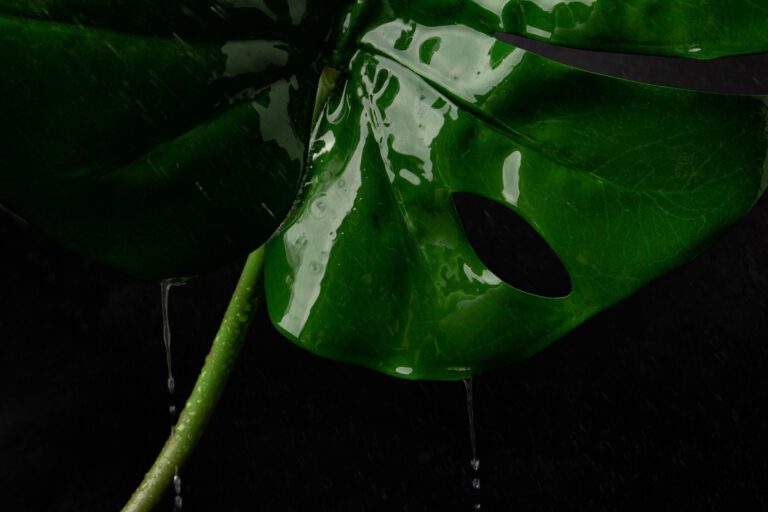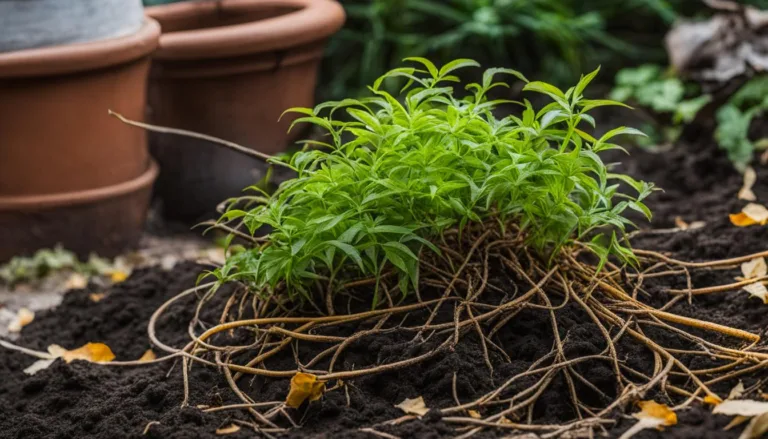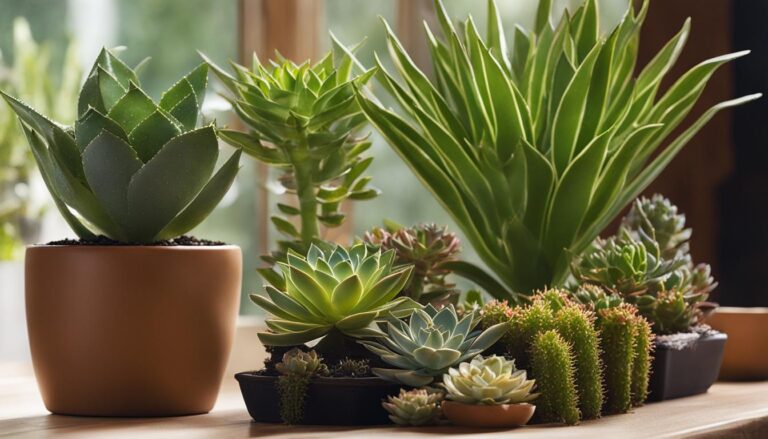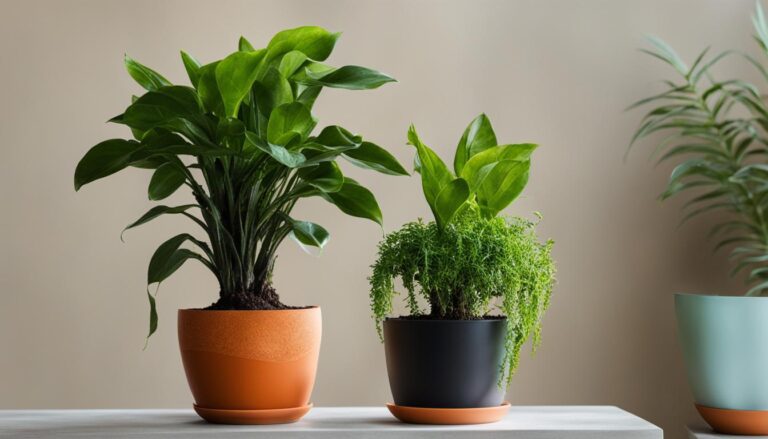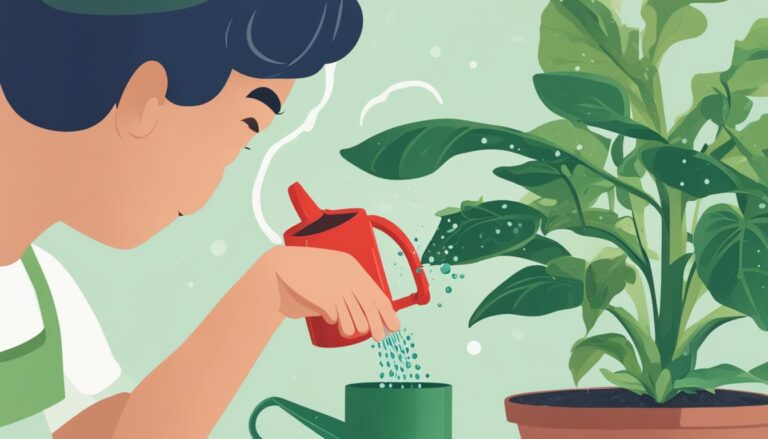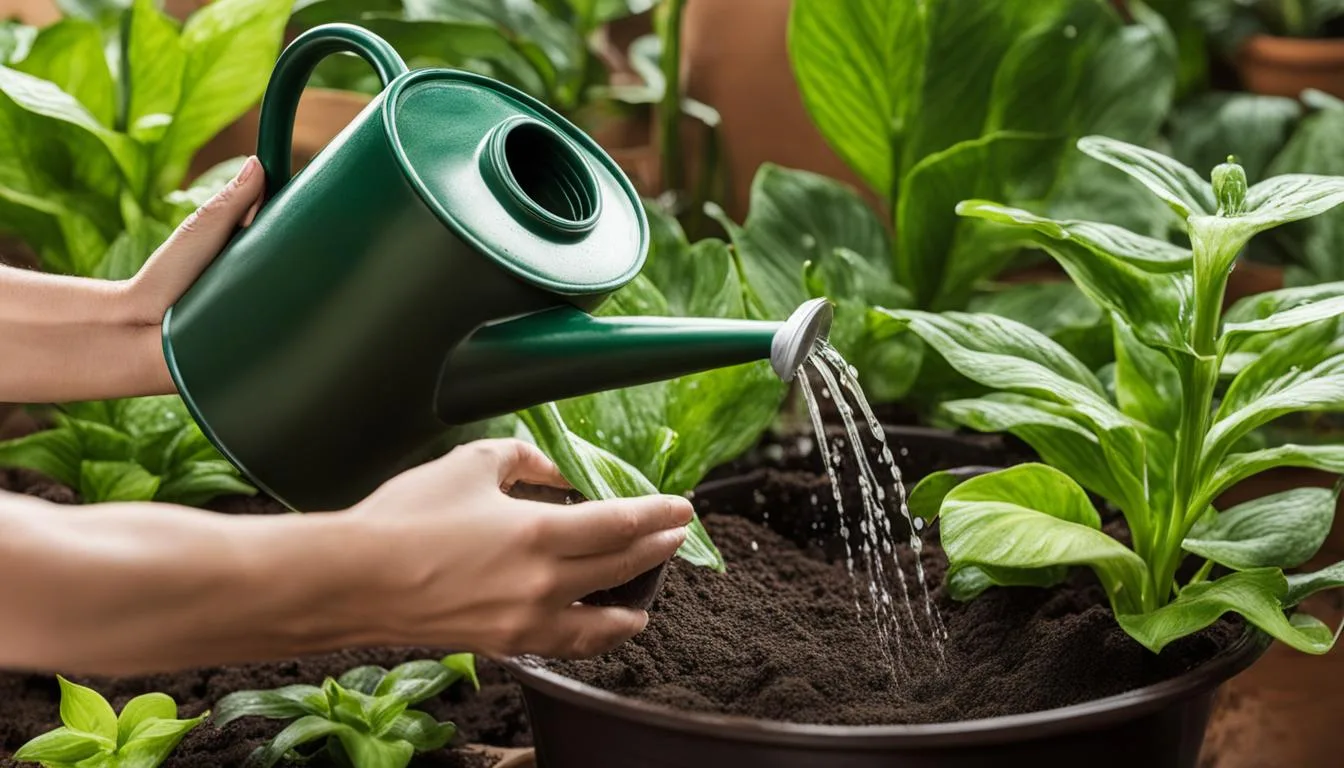
Hey there, plant lover! If you’re looking to add a touch of lushness to your indoor space, look no further than the beautiful Dieffenbachia plant. With its striking, vibrant leaves, this houseplant is sure to bring life to any room. But how do you achieve that enviable lush look? Well, fret not!
In this article, I’ll be sharing my top tips and tricks for caring for your Dieffenbachia plant, ensuring it thrives and becomes the centerpiece of your indoor oasis.
Key Takeaways:
- Provide bright, indirect light for your Dieffenbachia plant to thrive.
- Keep the soil consistently moist, but avoid overwatering.
- Choose a well-draining potting mix to ensure proper soil conditions.
- Regularly prune your Dieffenbachia to maintain its shape and promote healthy growth.
- Repot the plant every 1-2 years to prevent it from becoming root-bound.
Light Requirements for Dieffenbachia Plants
Dieffenbachia plants require specific light conditions to thrive and maintain their lush appearance. Understanding the light requirements is crucial for successful Dieffenbachia plant care.
Indirect Bright Light
Dieffenbachia plants thrive in bright, indirect light. While they can tolerate low light conditions, they will grow best when placed in a spot with bright, filtered sunlight. Direct sunlight can scorch their leaves, so it’s important to avoid exposing them to it. An ideal location for your Dieffenbachia plant is near a north or east-facing window, where it can receive ample, indirect sunlight throughout the day.
Protection from Harsh Rays
If you only have south or west-facing windows, it’s essential to protect your Dieffenbachia plant from direct sunlight. Use a sheer curtain to filter the light and prevent the plant from being exposed to harsh rays. By doing so, you can help maintain the health and vibrancy of the plant’s leaves.
Consistent Sunlight
Consistency is key when it comes to providing the right amount of sunlight for your Dieffenbachia plant. Aim to keep its location unchanged, as sudden changes in light exposure can cause stress to the plant. Avoid moving it from a low light area to a bright area abruptly, as this can shock the plant and lead to foliage problems.
Watering Tips for Dieffenbachia Plants
Proper watering is crucial for successful Dieffenbachia plant care. To ensure the health and vitality of your indoor plant, follow these watering tips:
- Consistent Moisture: Dieffenbachia plants prefer to be in soil that is consistently moist but not soggy. Avoid allowing the soil to dry out completely between waterings, as this can cause stress and lead to leaf drop.
- Touch Test: Check the moisture level of the soil by lightly pressing your finger into the top inch. If it feels dry to the touch, it’s time to water. If it still feels moist, wait a few more days before watering again.
- Avoid Overwatering: Overwatering can lead to root rot, which can be detrimental to the health of the plant. Ensure that the pot has proper drainage holes to allow excess water to escape. If the soil is consistently wet or the leaves start to droop, reduce the frequency of watering.
- Watering Method: When it’s time to water, thoroughly saturate the soil until water begins to drain out of the bottom of the pot. This helps to flush out any accumulated salts or minerals. Discard any excess water that collects in the saucer to prevent the roots from sitting in standing water.
By following these watering tips, you can provide your Dieffenbachia plant with the ideal level of moisture it needs to thrive.
Signs of Overwatering and Underwatering
| Signs of Overwatering | Signs of Underwatering |
|---|---|
| Yellowing leaves | Wilting leaves |
| Mushy or rotten roots | Dry, crunchy leaves |
| Foul smell from the soil | Soil pulling away from the sides of the pot |
Monitoring the moisture level of the soil and observing any signs of overwatering or underwatering will help you adjust your watering routine and keep your Dieffenbachia plant healthy.
Choosing the Right Soil for Dieffenbachia Plants
To ensure the healthy growth of your Dieffenbachia plants, it is crucial to choose the right soil. The ideal soil for Dieffenbachia plants is well-draining and retains moisture while allowing excess water to flow out easily.
A high-quality potting mix specifically formulated for indoor plants is the best choice. Look for a mix that contains peat moss, perlite, and other organic materials. These components provide proper drainage and aeration for the roots of the plant.
Avoid using heavy or compacted soils, as they tend to retain too much moisture and can lead to root rot. It’s also important to ensure that the pot has drainage holes to prevent waterlogging and maintain the health of the plant.
The Best Soil for Dieffenbachia Plants:
| Soil Component | Percentage |
|---|---|
| Peat moss | 50% |
| Perlite | 30% |
| Organic materials | 20% |
By using the right soil mix, you can create a suitable environment for your Dieffenbachia plants to thrive. This will ensure that the roots receive adequate moisture and oxygen, resulting in healthy growth and vibrant foliage.
Remember to repot your Dieffenbachia plant every 1-2 years to promote healthy root growth and prevent the plant from becoming root-bound. When repotting, use the same high-quality potting mix to maintain the optimal soil conditions for your plant.
Pruning Dieffenbachia Plants
Pruning is an essential part of indoor plant care for Dieffenbachia plants. Regular pruning helps maintain the plant’s shape and promotes healthy growth. It also allows you to remove any yellow or dead leaves, keeping your Dieffenbachia plant looking vibrant and lush.
When pruning Dieffenbachia, start by inspecting the plant for any damaged or discolored leaves. Using clean and sharp pruning shears, make clean cuts just above the stem joint to remove these leaves. This will not only improve the plant’s appearance but also prevent the spread of any potential diseases.
If your Dieffenbachia plant becomes too tall or leggy, you can trim back the stems to encourage bushier growth. Make sure to cut just above a leaf node, as this is where new growth will emerge. By pruning the stems, you stimulate new shoots to develop, resulting in a fuller and more compact plant.
Pruning Tips:
- To maintain the plant’s shape, prune regularly by removing yellow or dead leaves.
- When trimming back stems, cut just above a leaf node to encourage new growth.
- Use clean and sharp pruning shears to make clean cuts without damaging the plant.
- Prune during the growing season for the best results.
| Month | Pruning Tasks |
|---|---|
| Spring | Remove yellow or dead leaves, trim back stems if needed |
| Summer | Monitor for any additional pruning needs, maintain plant shape |
| Fall | Continue to remove yellow or dead leaves, assess overall plant health |
| Winter | Minimal pruning required, focus on regular maintenance |
By incorporating regular pruning into your Dieffenbachia plant care routine, you can ensure that your plant remains healthy and visually appealing. Remember to use clean tools and make precise cuts to avoid any damage to the plant. Pruning during the growing season and following the recommended pruning tips will help your Dieffenbachia thrive and flourish in your indoor space.
Repotting Dieffenbachia Plants
Repotting is an essential aspect of indoor plant care, and Dieffenbachia plants are no exception. It is necessary to repot your Dieffenbachia plant when it outgrows its current container, typically every 1-2 years. Repotting allows the plant to continue growing and prevents it from becoming root-bound, which can negatively impact its health.
When repotting your Dieffenbachia plant, choose a pot that is slightly larger than its current one. The new pot should have drainage holes to prevent waterlogging and ensure proper soil moisture levels.
Gently remove the plant from its current pot, being careful not to damage the roots. Loosen the roots if they are tightly packed, as this will encourage healthy root growth in the new pot.
Next, place the plant in the new pot and add fresh potting mix around it, ensuring that the roots are covered. Water the plant thoroughly after repotting to settle the soil and provide moisture to the roots.
It is important to repot your Dieffenbachia plant in the spring or early summer when it is actively growing. This will give the plant ample time to recover and adjust to its new pot before entering its dormant period.
| Steps for Repotting Dieffenbachia Plants |
|---|
| 1. Choose a pot slightly larger than the current one. |
| 2. Ensure the new pot has proper drainage holes. |
| 3. Gently remove the plant from its current pot, loosening the roots if necessary. |
| 4. Place the plant in the new pot and add fresh potting mix. |
| 5. Water the plant thoroughly after repotting. |
Repotting your Dieffenbachia plant not only provides it with a larger space to grow but also allows you to refresh the soil, promoting better nutrient uptake. Additionally, repotting can help prevent the plant from becoming top-heavy, ensuring it remains stable in its new container.
By following these steps and repotting your Dieffenbachia plant at the right time, you can promote healthy root growth and maintain the overall well-being of your plant.
Summary:
- Repotting is essential for Dieffenbachia plant care to prevent root-bound growth.
- Choose a slightly larger pot with drainage holes to ensure proper soil moisture levels.
- Gently remove the plant from its current pot and loosen the roots if necessary.
- Place the plant in the new pot, add fresh potting mix, and water thoroughly.
- Repot your Dieffenbachia plant in the spring or early summer when it is actively growing.
Dieffenbachia Plant Propagation
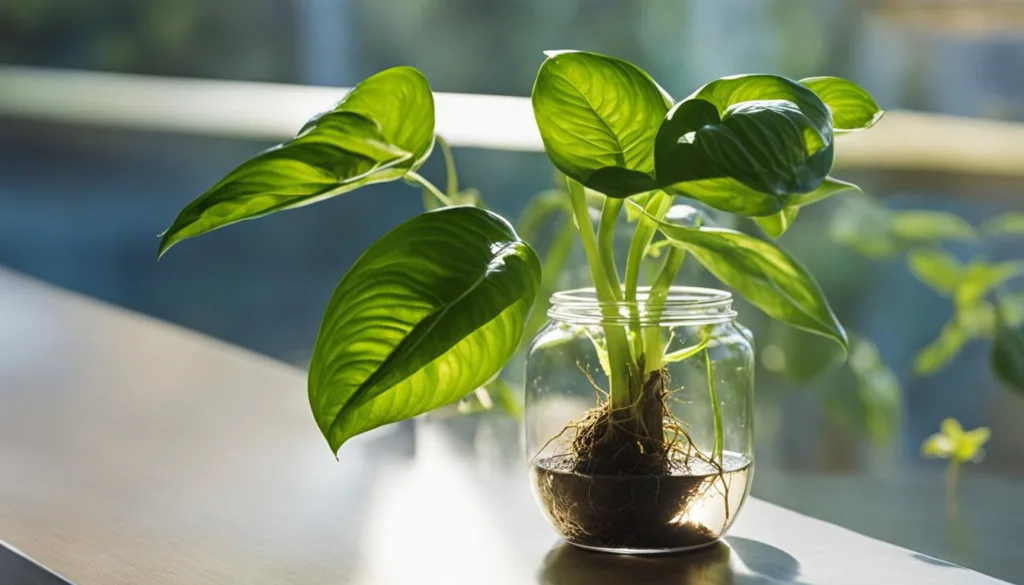
Propagation is an exciting way to expand your collection of Dieffenbachia plants. By following these simple steps, you can successfully propagate your Dieffenbachia and create new plants to enjoy.
To propagate Dieffenbachia plants, start by selecting a healthy stem and cutting a 6-8 inch section just below a node. Nodes are the points on the stem where leaves and buds emerge. Remove the lower leaves, leaving a few on the top to encourage growth.
Dip the cut end of the stem in a rooting hormone powder. This will help stimulate root growth and increase the chances of success. Plant the cutting in a well-draining potting mix, ensuring that the node is buried in the soil. Lightly water the soil to keep it moist, but not excessively wet.
Place the pot in a warm and humid environment to create the ideal conditions for root development. You can use a mini greenhouse made from a plastic bag or place the pot in a greenhouse if available. Keep the soil slightly moist and within a few weeks, you should start to see roots forming and a new plant taking shape.
This propagation method allows you to create new plants from your existing Dieffenbachia, giving you the opportunity to share the beauty of these tropical plants with others or expand your indoor garden.
Dieffenbachia Plant Toxicity
When caring for Dieffenbachia plants, it’s essential to be aware of their toxicity to humans and pets. The sap of the plant, if ingested or touched, can cause temporary numbness and interfere with speech. Hence, it is crucial to take precautions to ensure the safety of yourself, your loved ones, and your furry friends.
To prevent any accidental contact, always wear gloves when handling Dieffenbachia plants. Additionally, keep them out of reach of children and pets, placing them in areas where they cannot be easily accessed. If accidental contact does occur, wash the affected area thoroughly with soap and water.
Key Points:
- Dieffenbachia plants are toxic to humans and pets.
- Wear gloves when handling the plants to prevent any contact with the sap.
- Keep Dieffenbachia plants out of reach of children and pets.
- If accidental contact occurs, wash the affected area with soap and water.
By being cautious and taking the necessary safety measures, you can enjoy the beauty of Dieffenbachia plants while ensuring the well-being of everyone around them.
| Symptoms of Dieffenbachia Plant Toxicity | Precautions |
|---|---|
| Temporary numbness | Wear gloves when handling the plants. |
| Interference with speech | Keep the plants out of reach of children and pets. |
Recommended Accessories for Dieffenbachia Plant Care
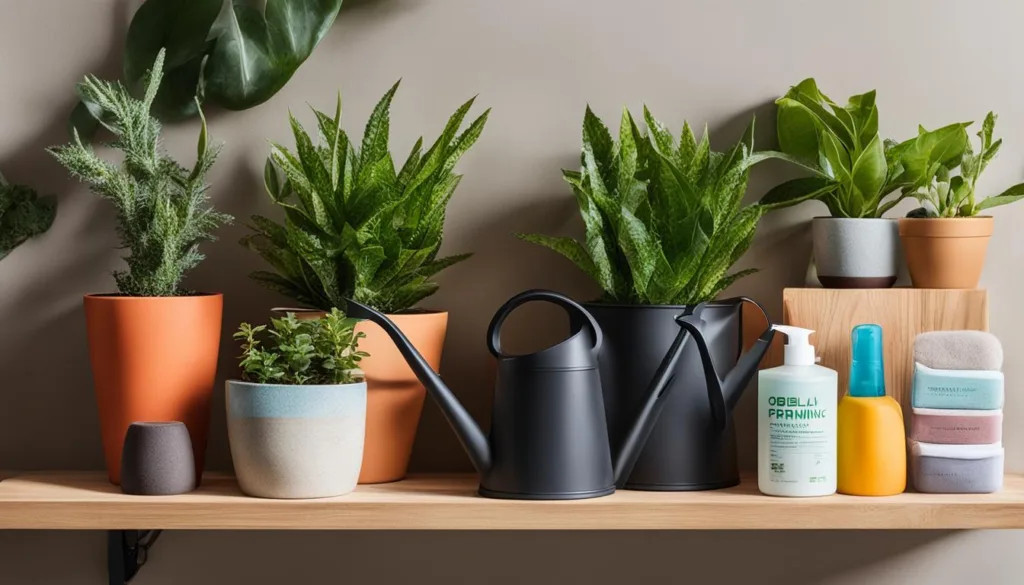
If you want to enhance your Dieffenbachia plant care routine, there are a few accessories that can make the process easier and more convenient. These accessories can help you maintain optimal conditions for your plant’s growth and ensure its overall health and well-being.
Purchase a Soil Probe
A soil probe is a handy tool that can help you determine the moisture level in the soil. This is especially important for Dieffenbachia plants, as overwatering can lead to root rot and other issues. By using a soil probe, you can ensure that you are watering your plant when it actually needs it, preventing overwatering and promoting healthy growth.
Invest in a Plant Saucer
If your Dieffenbachia plant pot has drainage holes, it’s essential to use a plant saucer. The saucer will catch any excess water that drains out of the pot, preventing it from spilling onto your furniture or floor. This not only helps keep your space clean but also prevents waterlogging, which can be detrimental to your plant’s health.
Consider a Self-Watering Pot
A self-watering pot can be a great investment for Dieffenbachia plant care. These pots have a built-in reservoir that holds water, allowing the plant to absorb moisture as needed. This ensures consistent moisture levels for your plant, reducing the risk of underwatering or overwatering. Self-watering pots can be especially beneficial if you frequently travel or have a busy schedule.
By incorporating these accessories into your Dieffenbachia plant care routine, you can create an optimal environment for your plant to thrive. Remember to always prioritize the specific needs of your plant and adjust your care routine accordingly. With the right accessories and proper care, your Dieffenbachia plant will continue to beautify your indoor space for years to come.
Growing Dieffenbachia Outdoors
Dieffenbachia plants can also be grown outdoors in suitable climates. If you live in warmer regions, such as zones 10 and 11, you can enjoy the beauty of Dieffenbachia plants in your garden or yard. Outdoor cultivation allows these plants to thrive in tropical conditions, where they can reach their full potential. Here are some essential tips for growing Dieffenbachia outdoors:
Choosing the Right Location
When selecting a location for your Dieffenbachia plant, look for an area that receives indirect sunlight. These plants prefer bright, filtered light rather than direct sunlight, which can scorch their leaves.
Plant them in shaded areas where they can enjoy warmth and humidity without being exposed to harsh rays. Protect the plants from strong winds and extreme temperatures, as they prefer a stable and temperate environment.
Providing Adequate Watering
Outdoor Dieffenbachia plants require regular watering to keep the soil consistently moist. Ensure that the soil drains well to prevent waterlogging, which can lead to root rot. Water deeply and thoroughly, allowing the water to penetrate the root zone.
During hot and dry periods, you may need to increase the frequency of watering to prevent the plant from drying out. Monitor the soil moisture level regularly and adjust your watering routine accordingly.
Maintaining Proper Soil Conditions
Choose well-draining soil for your outdoor Dieffenbachia plants. The soil should retain moisture while allowing excess water to flow out easily. A high-quality potting mix formulated for outdoor plants is ideal.
Alternatively, you can amend the soil with organic matter, such as compost, to improve drainage and fertility. Regularly check the soil pH and adjust it if necessary to provide optimal growing conditions for your plants.
| Outdoor Dieffenbachia Care Checklist |
|---|
| Choose a shaded location with indirect sunlight. |
| Water regularly, keeping the soil consistently moist. |
| Provide well-draining soil with good fertility. |
| Protect plants from strong winds and extreme temperatures. |
| Monitor for pests and treat them promptly. |
By following these outdoor plant care guidelines, you can create a lush and vibrant display of Dieffenbachia plants in your outdoor space. Enjoy the beauty of these tropical wonders as they enhance your garden or yard with their stunning foliage and graceful presence.
Troubleshooting Common Issues with Dieffenbachia Plants
As much as we love our Dieffenbachia plants, they can face a few common issues that can affect their health and appearance. Here are some troubleshooting tips to help you address these problems:
Yellowing Leaves
If you notice yellowing leaves on your Dieffenbachia plant, it could be a sign of overwatering, underwatering, or nutrient deficiencies. Check the moisture level of the soil and adjust your watering routine accordingly. You may also want to consider using a balanced fertilizer to provide the plant with the necessary nutrients it needs to thrive.
Brown Edges on Leaves
Brown edges on the leaves can be a sign of low humidity. Dieffenbachia plants prefer high humidity levels, so increasing the moisture in the air can help prevent this issue. You can mist the leaves regularly or use a humidifier to create a more humid environment for your plant.
Pest Infestations
Common pests such as mealybugs and aphids can infest Dieffenbachia plants. If you notice any signs of pest infestation, treat the plant with insecticidal soap or wipe them off with a cotton swab dipped in rubbing alcohol. Regularly inspect your plant for any signs of pests to catch the problem early and prevent it from spreading.
By addressing these common issues promptly and providing the necessary care, you can ensure that your Dieffenbachia plant remains healthy and vibrant.
Taking care of your Dieffenbachia plant is crucial to ensure its lush and healthy growth. By following the proper indoor plant care guidelines, you can enjoy the beauty of this tropical plant in your home or garden.
Remember to provide your Dieffenbachia plant with bright, indirect light, as it thrives in these conditions. Additionally, make sure to water your plant consistently, keeping the soil moist but not soggy. Choosing the right soil, pruning when necessary, and repotting every 1-2 years will also contribute to its overall health.
Furthermore, you can propagate new Dieffenbachia plants through stem cuttings, expanding your collection or sharing the joy of this beautiful plant with others. However, always be cautious when handling the plant due to its toxicity to humans and pets.
In summary, by following these indoor plant care tips and taking the necessary precautions, your Dieffenbachia plant will thrive, adding a touch of lush beauty to your indoor space.
FAQ
What is the best lighting for Dieffenbachia plants?
Dieffenbachia plants prefer bright, indirect light. Place them near a north or east-facing window for ideal light conditions.
How often should I water my Dieffenbachia plant?
Water the plant thoroughly when the top inch of soil feels dry to the touch. Avoid overwatering to prevent root rot.
What type of soil should I use for my Dieffenbachia plant?
Choose a well-draining potting mix that retains moisture while allowing excess water to flow out easily. Look for a mix with peat moss, perlite, and other organic materials.
How do I prune my Dieffenbachia plant?
Regularly remove yellow or dead leaves to maintain the plant’s appearance. If the plant becomes tall or leggy, trim back the stems to encourage bushier growth.
When should I repot my Dieffenbachia plant?
Repot the plant in spring or early summer when it outgrows its current container. Choose a slightly larger pot with drainage holes for the best results.
How can I propagate my Dieffenbachia plant?
Take stem cuttings, dip the cut ends in rooting hormone powder, and plant them in a well-draining potting mix. Keep the soil slightly moist until new roots develop.
Are Dieffenbachia plants toxic?
Yes, Dieffenbachia plants are toxic to humans and pets. Always wear gloves when handling and keep them out of reach of children and pets.
What accessories are recommended for Dieffenbachia plant care?
Consider using a soil probe to monitor moisture levels, a plant saucer to catch excess water, and self-watering pots for consistent moisture.
Can Dieffenbachia plants be grown outdoors?
In warmer climates, Dieffenbachia plants can be grown outdoors in shaded areas. In colder climates, it’s best to grow them indoors or in containers that can be brought indoors during winter.
How do I troubleshoot common issues with Dieffenbachia plants?
Yellowing leaves may indicate over or underwatering, nutrient deficiencies, or low humidity. Adjust watering, fertilize, and increase humidity as needed. Treat pests, such as mealybugs and aphids, with insecticidal soap or rubbing alcohol.

